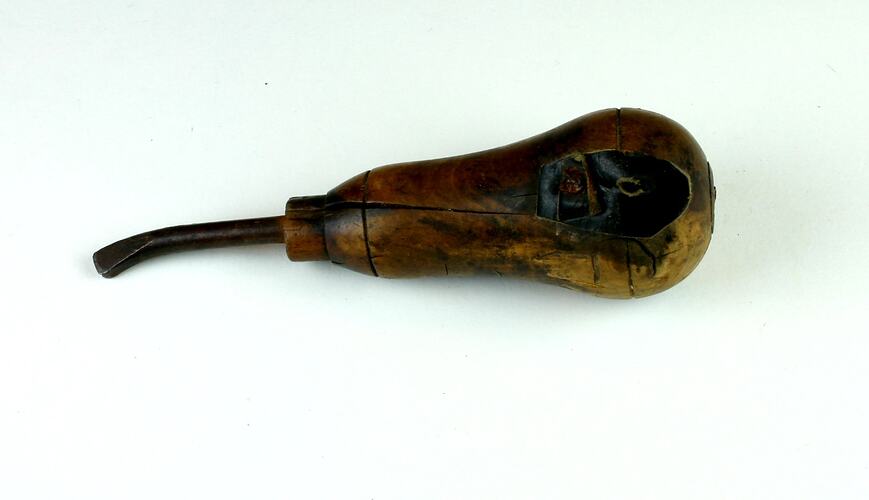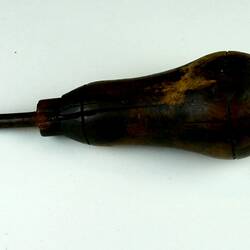Summary
This double stitch prick with its wooden handle, up-turned flattened blade with its central 'V' shape was used by Stanio Fancoff to provide both form and function within his shoemaking craft. This particular tool was used between each stitch to place indentations upon the welt. This process functioned to both tighten the stitch but also improve its aesthetics by making the stitch appear bolder and more prominent. Along with many other tools, this double stitch prick was an integral part of Stanio's shoemaking tool kit and invaluable when creating shoe aesthetics.
Stanio Ivanoff Fancoff was born in 1908 in Bojentsi, a small village in Bulgaria. At age 11, Stanio left home to learn the shoemaking trade. In 1929, he immigrated to Melbourne, settled in Fitzroy and began to work for the V.G. Zemancheff & Sons basket shoe factory in South Melbourne. In1936, he married Dorotea Georgi Touzou who had recently arrived in Australia. Around this time, Stanio set up his own shoemaking business from home, with Georgi, her cousin and sister weaving the shoes which he then assembled. Select shoe samples were then taken to Sydney and Tasmania for sale. In 1942, Georgi and Stanio moved to Broken Hill for Georgi's health; there daughter Nancy was born and Stanio set up a shoe shop/factory. In 1945, Georgi died and by 1950 Stanio and Nancy had moved to Adelaide where he again opened a shoemaking business and shop. He passed away in 1978, having been in the shoemaking business for 59 years. This collection documents his migration and working life experiences.
Physical Description
Although many stitch prick variations exist, they all commonly combine a blade with a wooden handle that resembles a small screwdriver. This particular tool is framed by a wooden necktie and the blade's end appears turned up, flattened with a central 'V' shape. The pear shaped handle has horizontally incised lines located within both the top and lower handle portions. The base exhibits the central metal tool end point encircled by an incised line. The light coloured wood exudes extensive dark areas possibly from stain or paint transference. Furthermore, two opposing vertical cracks running from top to the midway point expose the internal join of tool to handle, while three smaller cracks appear within the lower portion. Similar to many shoemaker tools, this double stitch prick has a dark tanned leather strap with a button hole plus an additional leather piece simultaneously singularly tacked the handle's lower portion.
Significance
This collection is significant in documenting a small migrant business as well as the fashion of a particular period. It is well provenanced and charts the application of trade skills in a new country. It also illustrates the stages of hand shoe manufacture from the 1930s, demonstrating the enduring nature of the tools and patterns that were used.
More Information
-
Collecting Areas
-
Acquisition Information
Donation from Nancy Vasileff, 21 Mar 2007
-
Past Owner or User
-
Classification
-
Category
-
Discipline
-
Type of item
-
Overall Dimensions
40 mm (Width), 120 mm (Height)
-
References
R.A. Salaman, 'Dictionary of Leather-working Tools c.1700-1950 and Tools of Allied Trades,' London: George Allen and Unwin (Publishers) Ltd, 1986 [Section 2: Boot and Shoe Maker pp18-185]. John Peacock. 'Shoes, The Complete Sourcebook,' London:Thames & Hudson Ltd, 2005. NAA holds file (online) on Vasil George Zemancheff, Fancoff's employer
-
Keywords
Boot & Shoemaking, Bulgarian Communities, Bulgarian Immigration, Immigration, Small Businesses, Tools



